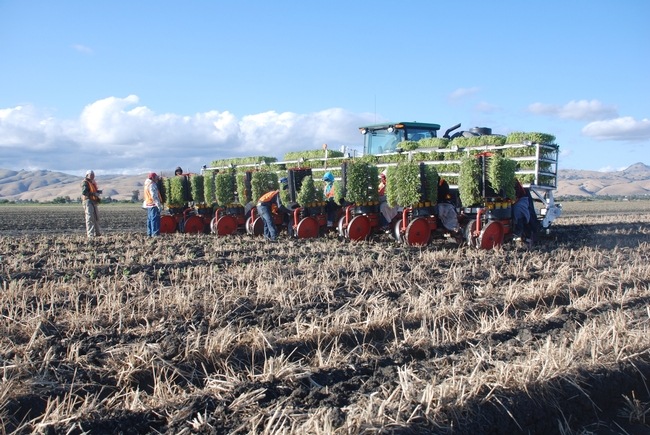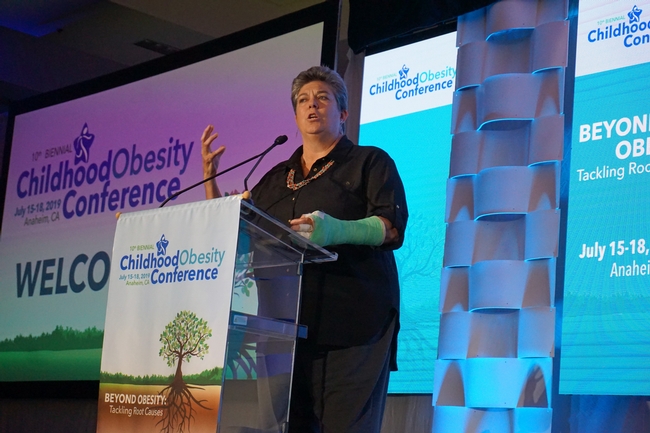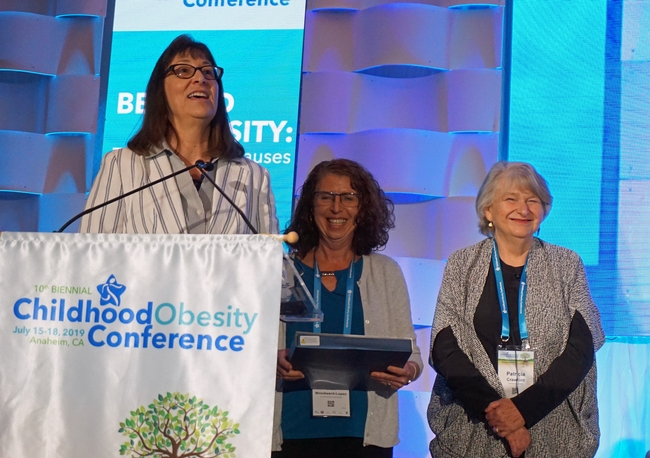Posts Tagged: Lorrene Ritchie
College students eligible for food assistance deterred by confusing requirements
Modifying Farm Bill could reduce barriers to SNAP for students and improve nutrition
Inadequate access to food can harm college students' health and academic performance. A recent University of California research study in the Journal of Nutrition Education and Behavior investigated why UC students who are eligible for the federal Supplemental Nutrition Assistance Program (SNAP) – the nation's largest food assistance program – do not receive the benefit.
“Based on our study findings, eliminating the extra requirements for college students to qualify for SNAP would go a long way in ensuring that more eligible students get the support they need to meet their basic food needs,” said study coauthor Lorrene Ritchie, director of the UC Nutrition Policy Institute, which is part of UC Agriculture and Natural Resources.
A 2015 study by NPI found four in 10 UC students didn't have enough money to buy sufficient food for a healthy lifestyle. To promote better health, UC has taken steps to ensure students are aware of SNAP, established campus food pantries and other basic needs resources.
"In California, SNAP is known as CalFresh and despite policies and communication to improve college students' access to CalFresh, participation remains low, with approximately 78% of those eligible not receiving benefits," said lead study author Suzanna M. Martinez, associate professor in the Department of Epidemiology and Biostatistics at UC San Francisco.
For insight on why low-income UC students aren't receiving the benefits, Martinez, Ritchie and colleagues at UC San Francisco and Nutrition Policy Institute consulted county agencies that process student CalFresh applications. The researchers interviewed county staff in nine counties that are home to UC campuses: Alameda, Los Angeles, Merced, Orange, Riverside, San Francisco, Santa Barbara, Santa Cruz and Yolo.
While CalFresh benefits have mainly been paid by the federal government through the Farm Bill, counties contribute and county agencies are responsible for implementing policies, determining eligibility, processing applications and distributing funds.
“With the Farm Bill still up for reauthorization, these findings could provide insight into how to strengthen SNAP policy related to eligible students,” Martinez said.
The researchers conducted focus groups and interviews with county staff to determine how agency workers interpret the complex criteria for students to meet CalFresh eligibility.
Their questions focused on how students' applications differed from those of community members, steps taken when processing student applications, student-specific training and suggested improvements to the process.
Five central themes were identified in the interviews:
- More consistent policy dissemination and program administration is needed
- Student exemptions and the application process are perceived as challenges for students
- Key supports for successful student applications include carefully reviewing applications for potential exemptions, providing useful resources to students, and campus partnerships
- Tracking policy changes is burdensome
- Eliminating student rules and treating students as regular clients would be more equitable
The researchers found that CalFresh rules are challenging for students as well as the county agency staff.
Also, eligibility requirements, written over 50 years ago, are based on the assumption that college students are supported by middle-class families.
The research supports simplifying the student CalFresh process to increase participation for eligible students, especially for historically underrepresented racial and ethnic groups and low-income students for whom equitable access to CalFresh benefits is critical.
“Once students get confused or don't know what they need to do, they don't follow through with their application,” one CalFresh eligibility worker told the researchers.
During the COVID-19 pandemic, some federal and state requirements were waived or relaxed for students.
“The timing of this study resulted in a natural experiment since COVID-19-related SNAP modifications streamlined the student application process and reduced administrative burden,” Martinez noted. “These modifications alleviated some challenges discussed by county workers, confirming existing opinions to eliminate the student rules.”
Ritchie said, “We hope our research informs policy to remove some of the barriers so students no longer have as much difficulty getting the food they need.”
This study was funded by the California State Legislature, which provided funding to the University of California to address students' basic needs (UC Basic Needs Initiative).
Fighting hunger and building planet health go hand in hand
University leaders, faculty and students from across the U.S. and around the world are working together to tackle a complex set of challenges that prevent millions of people from getting enough of the right foods. In March 2021, UC Davis, the UC Global Food Initiative and the UC Agriculture and Natural Resources Nutrition Policy Institute, in partnership with the Hunger Solutions Institute at Auburn University, hosted a summit for members of Universities Fighting World Hunger, where more than 500 attendees from 22 countries sought solutions to the tragedy of world hunger, food insecurity and malnutrition that results in chronic diseases and obesity.
The 16th annual summit, held virtually for the second time, introduced a new way to address hunger by focusing on its connections to global climate change and the catastrophic COVID-19 pandemic.
Opening keynote speaker Bill Dietz, director of the Redstone Global Center for Prevention and Wellness at George Washington University, called the multiple threats to human well-being a “syndemic” driven by political power, capitalism, social norms and structural racism.
He suggested triple-duty solutions to the syndemic. For example, for U.S. populations, increasing plant-based foods and reducing beef consumption leads to (1) healthier diets that reduce obesity, diabetes and cancer; (2) improves nutritional quality and food security; and (3) lowers greenhouse gas emissions from agriculture and cattle production.
“I don't mean to say we eliminate beef,” Dietz said. “Beef can be healthy if grass fed and contains micronutrients. We need to reduce it. I don't pretend that's an easy lift. There is resistance at the highest levels of government. But we need to generate the political will to turn that around.”
Dietz recommended the development of local and regional food systems for food resilience, health, equity and environmental sustainability. Regional systems are more agile and not devoted to monoculture, such as that found in the U.S. Midwest where great swaths of land are managed exclusively for corn production.
“The question is not what we need to do, but how to do it,” Dietz said. “We need to act now. We need to build political will. We need to hold leaders accountable.”
A new Green Revolution
On the world stage, increasing access to food must address poverty, inequality, wars and politics, said Rattan Lal, distinguished professor of soil science at Ohio State University.
The projections that the earth will have 2 billion more residents by 2050 means there's a need for a new “Green Revolution,” Lal said. In the 1950s, fears that food production was lagging behind population growth were rampant. The fears were not realized due to the mid-century Green Revolution, in which research and technology boosted agricultural production worldwide with advances in variety selection, irrigation, synthetic fertilizers and pesticides. Yields rose exponentially.
“This miracle saved hundreds of millions from starvation,” Lal said. “Despite all that progress, there is still hunger.”
To meet food demand anticipated in 2050, the new Green Revolution must be different.
“Rather than input based, it must be natural resources based,” Lal said. “The strategy is to produce more food from less land, less water, less fertilizers and less energy.”
Managing agricultural land with regenerative principles – such as maintaining year-round soil cover, eliminating tillage and applying integrated nutrient management – leads to healthy, sustainable and productive soils that lock up carbon and minimize greenhouse gas emissions to the atmosphere.
“Something I hope to see protected in the new Farm Bill – the rights of soil,” Lal said. “Soil is a living entity. It has rights. We have a Clean Air Act, a Clean Water Act. It is time for a Healthy Soil Act. I hope it will be in 2022 or 2023. That involves policy translating science to action.”
The benefits of soil health are research-proven, but not yet widely implemented on farmland around the world, an example of a dichotomy shared by summit keynote speaker Jeffrey Sachs, an economist with the Center for Sustainable Development. He quoted the well-known observation of science fiction writer William Gibson, “The future is already here – it's just not evenly distributed.”
“There are solutions. I call them pathways. They are not gimmicks,” Sachs said. “Our work is to build the public understanding and awareness of the importance of these pathways.”
Sachs encouraged summit attendees to advocate locally and at the state and federal levels to promote new food systems approaches.
“Write blogs, op-eds and suggestions. What can corporations commit to? What should governments commit to? What can the food industry commit to?” Sachs said. “A lot of agricultural policies promoted by large commercial interests neglect environmental objectives. What we need is a one-world approach to move beyond the narrow view of a powerful corporate lobby and move to ecosystem sustainability in agriculture, carbon storage, healthful diets and a culture of appreciation of agriculture and healthful food.”
A role for land grant universities
Lorrene Ritchie, director of UC's Nutrition Policy Institute, said she believes UC Agriculture and Natural Resources and other land grant institutions can help direct humanity along a pathway of human and planet health.
“We have nutrition programs, dairy and beef research, irrigation, pest control, production, and natural resources expertise, and are well positioned to work together,” Ritchie said. “As a nutrition researcher, I can bring expertise on human dietary needs, while others can identify the crops that are most environmentally sustainable in different ecosystems. How we can get the best nutrition with the smallest environmental impact is the key question to address.”
Consumers can also help protect the planet's health with information to make educated decisions about their food choices.
“I would like to see food labeling not only for nutrition, but also on the product's sustainability,” she said.
Impacts from food on the planet's health involve production, water use, transportation, packaging and other factors.
“It kind of makes you dizzy to think about balancing impacts to human health and planet health. At UC ANR, we have the expertise and we can contribute to making progress in California and beyond in that regard. Complex problems will require multiple solutions – the time to act is now,” Ritchie said.
New policies can inspire families to provide healthy beverages to children
At fast food and sit-down restaurants across California, kids' meals come with water or milk automatically. At least, that should be the case since state law requires restaurants to offer the healthy beverages by default to reduce the amount of sugary beverages served to children.
California Senate Bill 1192, authored by Sen. Bill Monning (D-San Luis Obispo), went into effect Jan. 6, 2019, but research by the UC Nutrition Policy Institute (NPI) has found that implementation has not been universal and more can be done. The results, along with results from a similar study in Wilmington, Del., were published Aug. 20 on HealthyEatingResearch.org.
Before the law, 10% of menu boards observed by the researchers in California listed only the healthy beverages. Data collected after the law went into effect showed 66% of menu boards list the healthy default beverages. The researchers also collected data on the proportion of cashiers who verbally offered only healthy beverages with kids' meals when orders were placed. This happened only 5% of the time before the law was enacted, and dropped to 1% after.
“Parents look at menu boards and kids look at menu boards, but it is likely that what the cashier says also influences which drink they choose,” said Lorrene Ritchie, NPI director and UC Cooperative Extension nutrition specialist. Ritchie was the lead researcher on the California portion of the study. “In our data collection, we would order a kids' meal and wait for them to offer a drink. But mostly they said, ‘What drink do you want?' instead of ‘Do you want water or milk with that?'”
The law doesn't specify whether the cashier must offer the default beverages, but the spirit of the law suggests they should, as it would likely have a greater impact on the selections that children and parents make, Ritchie said.
According to Gail Woodward-Lopez, an NPI researcher and co-investigator on the study, most restaurant managers expressed support for the legislation, but didn't know much about it.
“NPI in partnership with the California Department of Public Health is working with some local health departments to provide training and materials to help restaurants comply with the letter and spirit of the law,” Woodward-Lopez said. “Our next step is to measure whether this health department support is effective.”
The dire need to direct children away from sugary sodas is clear. Empty calories from soda and other sugar-sweetened beverages is the No. 1 cause of obesity in children, Ritchie said. Obese children are at least twice as likely as non-obese children to become obese adults. Obese children and adults are at greater risk for Type 2 diabetes, heart disease, stroke, high blood pressure, high cholesterol, certain cancers, asthma, low self-esteem, depression and other diseases. The Centers for Disease Control and Prevention names obesity as one of the conditions that increase risk of severe illness from COVID-19.
Many open questions remain, such as how drinks are portrayed on drive-thru signs and offered by drive-thru order takers. The COVID-19 pandemic has also altered the way Americans purchase food, with increased online ordering, delivery and drive-thru usage. In-store kiosk ordering is also growing in popularity.
“The role of default beverage policies in this context is important and not well understood,” Woodward-Lopez said.
Woodward-Lopez and Ritchie are working with colleagues around California and across the country to design follow-up studies of newer food technologies and beverage policies being passed elsewhere, to determine how government policies can protect children's health by steering them toward healthy beverage consumption.
The newly published research was funded by the Robert Wood Johnson Foundation and by the California Department of Public Health with funding from the United States Department of Agriculture.
Removing sodas for sale at UCSF helps cut sugar consumption and improve health
A study of the first University of California campus (UC San Francisco) to ban the sale of soda on campus has shown that employees reduced their consumption by nearly 50 percent. UCSF staff who took part in the study also reduced their waist measurements and weight.
“This was not a ban on the consumption of sugared beverages,” emphasized co-lead author Laura Schmidt, PhD, MSW, MPH, UCSF professor in the Philip R. Lee Institute for Health Policy Studies. “This was a ban on sales on sugary beverages in vending machines, break rooms and cafeterias...People could still bring them from home or buy them off campus.”
The study was published Oct. 28, 2019, in the Journal of the American Medical Association, Internal Medicine.
California Assembly Member Richard Bloom (D–Santa Monica) noted the importance of workplace and governmental restrictions on soda sales while communities are prohibited from establishing local soda taxes for the next 12 years. In June 2018, the beverage industry strong-armed the California Legislature and Governor into enacting a “preemption” law that prohibits communities from passing local soda taxes.
“Workplace restrictions enable communities to take charge of their own health as we build momentum to pass AB 138, my bill that establishes a statewide soda tax that will fund prevention efforts. The bill will reduce soda consumption and generate positive health outcomes in impacted communities, where most needed, just like the UCSF effort,” Bloom said.
Lorrene Ritchie, UC Cooperative Extension specialist and director of the UC Nutrition Policy Institute, which conducts nutrition research to strengthen public policy, commented: “I am so impressed with both UCSF's sales ban and this very well-done study. Sodas are such a huge contributor to our obesity crisis that it is heartening to recognize a solution that any employer can adopt to help people improve their lives.”
Speaking of the UCSF study, lead author Elissa Epel, PhD, UCSF professor of psychiatry and director of the UCSF Aging, Metabolism, and Emotions Center, said: “This shows us that simply ending sales of sugary drinks in the workplace can have a meaningful effect on improving health in less than one year. There is a well-known pathway from soda to disease. High sugar intake leads to abdominal fat and insulin resistance, which are known risk factors for diabetes, heart disease, cancer and even dementia. Recent studies have also linked sugar intake to early mortality.”
Children are getting healthier, but the obesity crisis is not over
Real progress has been made in tackling the epidemic of childhood obesity since the first California Childhood Obesity Conference was held 20 years ago, but there is more work to be done.
“Collectively, we have come so far,” UC Nutrition Policy Institute Director Lorrene Ritchie told an audience of 1,025 public health, nutrition education, research, and other professionals at the event in Anaheim in July 2019. NPI was one of six conference hosts.
In the last 20 years:
- Federal school meal standards have been revised so that the food children eat at school is healthier than the lunches they bring from home.
- Sugar-sweetened beverages are no longer available to students during the school day.
- Foods provided by the Special Supplemental Nutrition Program for Women, Infants and Children (WIC) are healthier and give mothers incentive to breast feed their babies.
- The Supplemental Nutrition Assistance Program (SNAP) education component is now linked to policy, systems and environmental changes.
- The Child and Adult Care Food Program now provides healthier meals and snacks to children in childcare centers and homes across the country.
The average quality of the diet of American children has improved, but the rate of childhood obesity in the United States is still too high.
According to the Centers for Disease Control and Prevention, 18.5% of U.S. children and adolescents 2 to 19 years old are obese – about 13.7 million youth in all. The rates trend higher in minority communities, with 25.8% of Latinx youth and 22% of African American youth obese. Obesity is also more prevalent among children in families with low incomes.
Obesity, which is defined in children as a body mass index at or above the 95th percentile of CDC growth charts, is associated with poorer mental health status, reduced quality of life, and increased prevalence of diabetes, heart disease, stroke and some types of cancer.
The vice president of UC Agriculture and Natural Resources, Glenda Humiston, pledged the organization's commitment to community health and wellbeing at the Childhood Obesity Conference. UC ANR is the umbrella organization of the Nutrition Policy Institute, UC CalFresh Healthy Living, UC Cooperative Extension, 4-H Youth Development, the UC Master Gardener Program and the California Naturalist Program, among others.
“Going forward, solutions to the obesity epidemic are multidisciplinary,” Humiston said. “NPI does world class work in conducting research to influence nutrition policy. We need to harness 4-H. Master Gardeners are increasingly focusing on edible gardens. CalNat is getting people out into nature. We are finding synergies in community wellness.”
Humiston has dedicated UC ANR resources to finding and implementing solutions to the obesity crisis.
“I'm looking forward to working with all of you – public and private organizations – to design a way to move forward,” she said.
The opening keynote presentation at the conference featured Patricia Crawford, NPI's Senior Director of Research emeritus, a pioneer in addressing the growing problem of childhood obesity during her long career. Beginning in the 1970s, she recognized that childhood obesity was on the rise and launched several studies to search for the causes and potential solutions.
In one study, Crawford followed a group of 9-year-old African American girls over a period of 10 years to determine why these youth were growing up heavier than other adolescents.
“Finally, we began to get some answers,” Crawford said. “We learned obesity wasn't the children's fault. They were living in environments that made the unhealthy choice cheaper and easier to find. It's so unfair for people who have fewer resources. Health disparities has to be the No. 1 thing we are working on to address chronic disease rates in this country.”
“The solution to obesity is prevention. It's cheaper and more effective than treatment,” Crawford continued. “Healthy food is a taste that is easy to acquire if it is not preempted by junk food.”
Crawford said she honed in on the best strategies for prevention by actively listening to people struggling to make healthy choices
“There is a chasm between research and community,” Crawford said. “We have to get people together from the research level and the policy level with folks on the ground. We need to learn from people.”









